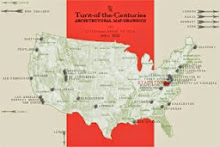 Frank Lloyd Wright's modest yet emblematic home for the young family of a newspaperman was rendered vivid for us by an amazing guide, this fellow in the bright red sweater vest.
Frank Lloyd Wright's modest yet emblematic home for the young family of a newspaperman was rendered vivid for us by an amazing guide, this fellow in the bright red sweater vest. Its preservation story is interesting and explains its current setting on the grounds of Woodlawn, an early 1800s plantation, home of George Washington's nephew and Martha Washington's granddaughter which adjoins Mount Vernon - seemingly odd neighbors for this mid-century "Usonian House, a manifesto of Wright's belief in American design for the people, unburdened by past architectural traditions."
The Pope-Leighey house was built in 1940 in Falls Church for the Pope family of middle-class means. It is easily recognizable as a cousin of Fallingwater in its natural site, materials, emphasis of compression and expansion of interior space, built-in storage for minimal possessions that is part of the architecture and many other of Wright's trademarks. The house was to be demolished in the 1960s due to the widening of a highway through Falls Church (Route 66.) The second owner of the house, Marjorie Leahey donated the house to the National Trust. A site was secured at Woodlawn, sculpted to imitate its original Falls Church site. The house was dismantled and re-built here only to be dismantled and re-built again in 1995 after it was discovered that it was sliding and sinking in the clay soil and that it was not correctly positioned in the first place. The cost was $500,000; compare that to its initial cost to build in 1940, $7,000. The house is built of natural, untreated cypress from Florida and with bricks, wood and clay of the earth.
The house is built of natural, untreated cypress from Florida and with bricks, wood and clay of the earth.  Operable glazing fit to the corners visually and spatially expands the indoor living space outdoors. The horizontal wings on axis create a low profile, with roof overhangs exaggerated in some places.
Operable glazing fit to the corners visually and spatially expands the indoor living space outdoors. The horizontal wings on axis create a low profile, with roof overhangs exaggerated in some places.  A banded clerestory and vertical lite pattern cut into the cypress siding further breaks the box and blurs it endges. The pattern is curious and, according to our guide, of unknown origin. (My guess is the abstracted outline of Massachusetts, with a shorter Vermont scrunched down beside.)
A banded clerestory and vertical lite pattern cut into the cypress siding further breaks the box and blurs it endges. The pattern is curious and, according to our guide, of unknown origin. (My guess is the abstracted outline of Massachusetts, with a shorter Vermont scrunched down beside.)





 Chipped concrete remains of tennis courts and walking paths that meandered among specimen trees with spectacular views back to the city. The rural life in view of the city and civilization was deemed ideal for convalescence.
Chipped concrete remains of tennis courts and walking paths that meandered among specimen trees with spectacular views back to the city. The rural life in view of the city and civilization was deemed ideal for convalescence.  The still-bucolic campus is within the District boundaries, on the east side of the Anacostia River. One can look across the river, scan the landmarked skyline and imagine the residents of St Elizabeths convalescing here, taking walks, writing (like Ezra Pound who spent several years here - second story, second window left of main entrance), tending their gardens, and - perhaps less bucolic - submitting to treatment for their ills. The "excited" patients were segregated within the Kirkbride building, as were men and women, as were the races. A separate building on the western edge of campus housed the criminally insane.
The still-bucolic campus is within the District boundaries, on the east side of the Anacostia River. One can look across the river, scan the landmarked skyline and imagine the residents of St Elizabeths convalescing here, taking walks, writing (like Ezra Pound who spent several years here - second story, second window left of main entrance), tending their gardens, and - perhaps less bucolic - submitting to treatment for their ills. The "excited" patients were segregated within the Kirkbride building, as were men and women, as were the races. A separate building on the western edge of campus housed the criminally insane. 



















 Fairlington is equidistant from Old Town Alexandria and the District. I can drive into the District in less than ten minutes, depending on traffic, and bike there in about 45 minutes via the excellent trail network that converges on Shirlington. Good restaurants abound in
Fairlington is equidistant from Old Town Alexandria and the District. I can drive into the District in less than ten minutes, depending on traffic, and bike there in about 45 minutes via the excellent trail network that converges on Shirlington. Good restaurants abound in 










 Traditional townhouses moulded to the landscape.
Traditional townhouses moulded to the landscape. It is seldom that the front door actually fronts the street to which it is addressed which makes for interesting directions when inviting friends over to your house. My door fronts a lovely wooded path
It is seldom that the front door actually fronts the street to which it is addressed which makes for interesting directions when inviting friends over to your house. My door fronts a lovely wooded path 



















